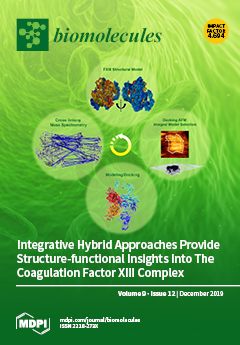Edible plant fruits are safe raw materials free of toxicants and rich in biomolecules for reducing metal ions and stabilizing nanoparticles. Zinc oxide nanoparticles (ZnONPs) and titanium dioxide nanoparticles (TiO
2NPs) are the most produced consumer nanomaterials and have known antibacterial activities
[...] Read more.
Edible plant fruits are safe raw materials free of toxicants and rich in biomolecules for reducing metal ions and stabilizing nanoparticles. Zinc oxide nanoparticles (ZnONPs) and titanium dioxide nanoparticles (TiO
2NPs) are the most produced consumer nanomaterials and have known antibacterial activities but have rarely been used against phytopathogenic bacteria. Here, we synthesized ZnONPs and TiO
2NPs simply by mixing ZnO or TiO
2 solution with a lemon fruit extract at room temperature and showed their antibacterial activities against
Dickeya dadantii, which causes sweet potato stem and root rot disease occurring in major sweet potato planting areas in China. Ultraviolet–visible spectrometry and energy dispersive spectroscopy determined their physiochemical characteristics. Transmission electron microscopy, scanning electron microscopy, and X-ray diffraction spectroscopy revealed the nanoscale size and polymorphic crystalline structures of the ZnONPs and TiO
2NPs. Fourier-transform infrared spectroscopy revealed their surface stabilization groups from the lemon fruit extract. In contrast to ZnO and TiO
2, which had no antibacterial activity against
D. dadantii, ZnONPs and TiO
2NPs showed inhibitions on
D. dadantii growth, swimming motility, biofilm formation, and maceration of sweet potato tuber slices. ZnONPs and TiO
2NPs showed similar extents of antibacterial activities, which increased with the increase of nanoparticle concentrations, and inhibited about 60% of
D. dadantii activities at the concentration of 50 µg∙mL
−1. The green synthetic ZnONPs and TiO
2NPs can be used to control the sweet potato soft rot disease by control of pathogen contamination of seed tubers.
Full article






